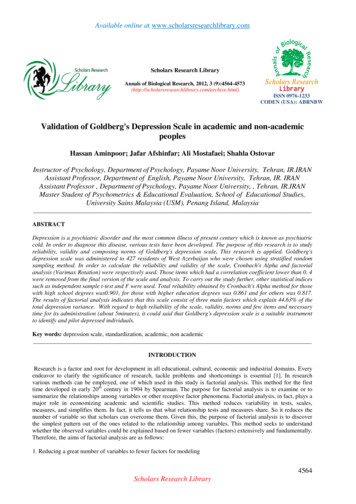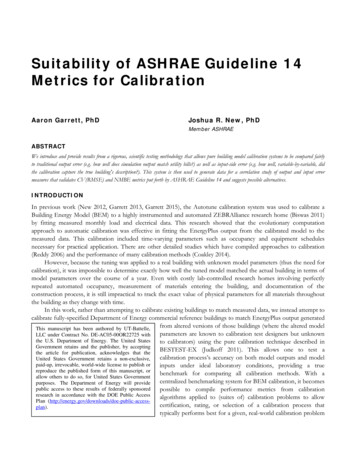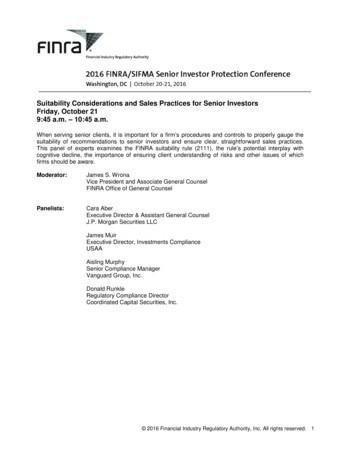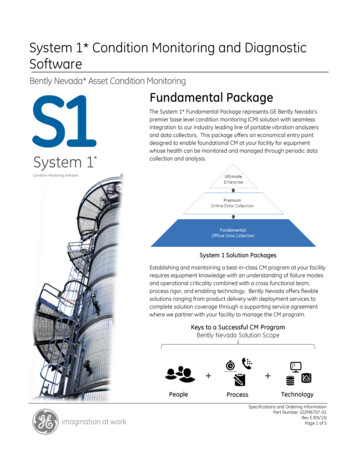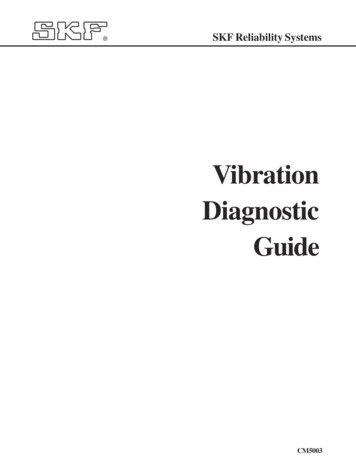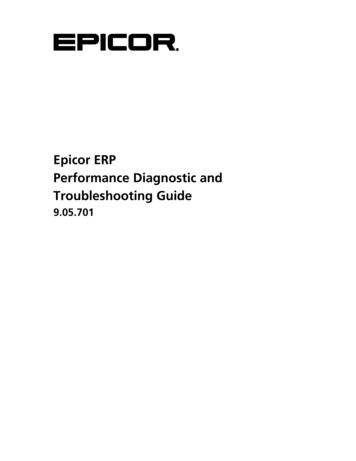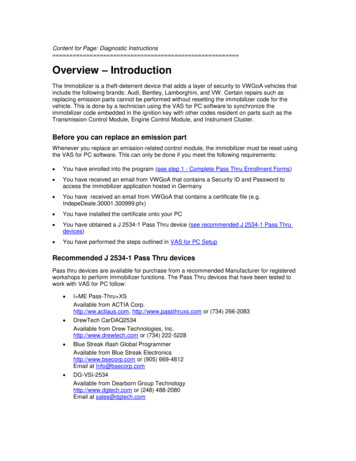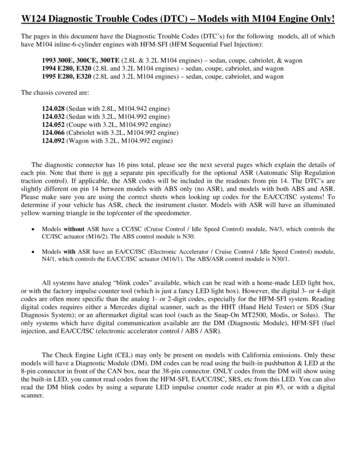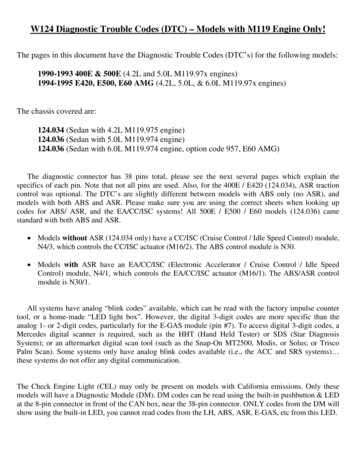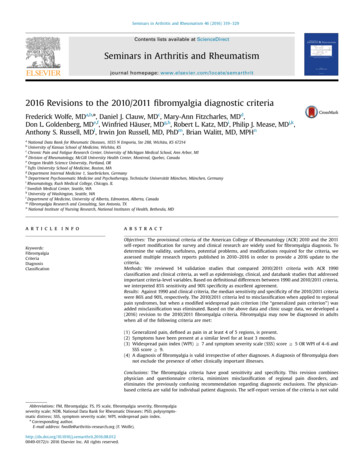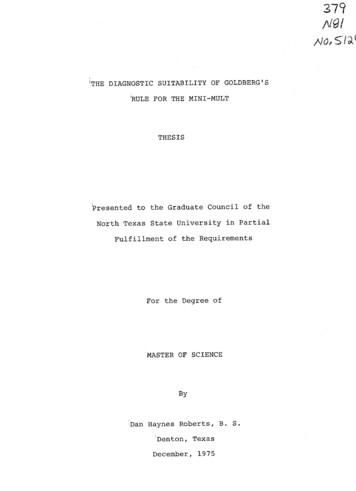
Transcription
379N1THE DIAGNOSTIC SUITABILITY OF GOLDBERG'S'RULE FOR THE MINI-MULTTHESISPresented to the Graduate Council of theNorth Texas State University in PartialFulfillment of the RequirementsFor the Degree ofMASTER OF SCIENCEByDan Haynes Roberts, B. S.Denton, TexasDecember, 1975
ABSTRACTRoberts, Dan H., The Diagnostic Suitability of Goldberg'sRule for the Mini-Mult.Master of Science(ClinicalPsychology), December, 1975, 47 pp., 6 tables, references,45 titles.This study was undertaken to determine whether theMini-Mult is able to function as well as the MMPI for alimited clinical purpose, the discrimination of psychosisand neurosis by Goldberg's rule.Mini-Mult(71 items)The smaller size of theallows conservation of time .and energyby subjects and professionals.Thirty male residents ofthe Austin State Hospital completed two standard MMPIs andone oral Mini-Mult.A fourth set of scores was obtainedby extracting Mini-Mult from the first MMPI.Correlationsand tests of significance were computed for raw scores andGoldberg's index scores.Results indicate no significantdifferences in the discrimination of psychosis and neurosisbetween the MMPI and the Mini-Mult.
TABLE OF CONTENTSPage.LIST OF TABLES . . . . . . . . . . . . . . . . . . . .ChapterI.INTRODUCTION. .1Statement of the ProblemPurpose of the StudyReview of the LiteratureRationaleII.METHODS. .24III.RESULTS. . . . . . . . . . . . . . . . . . . . .30IV.DISCUSSION . . . . . . . . . . . . . . . . . . .41APPENDIX. . . . . . . . . . . . . . . . . . . . . . . .45. . . . . . . . . . . . . . . . . . . . . .61REFERENCES.iii
LIST OF TABLESTableDates of Current Hospital Admissions,Dates of Testing, Number of PriorAdmissions to a Psychiatric Hospital and Ages of Subjects.*. .26Means and Standard Deviations of theScale Scores for the Two Administrations of the Two Forms.35.1.Page3.4.5. 36 . . .Correlations Between ComparableScales for all Combinationsof the Two Administrations ofthe Two Forms. .0.Percentages of Agreement BetweenCombinations of the Two Administrations of the Two Test Forms.8.9.373839Means and Standard Deviations ofGoldberg's Index Scores for theTwo Administrations of the Two Forms.40Scores on Goldberg's Index for the TwoAdministrations of the Two Forms.46High Point Scales on the Four Tests.48.7.Correlations of Goldberg's PsychoticNeurotic Index Scores for Combinations of the Two Administrations of the Two Test Forms.6.Students' t Vatues and Significanceof Differences Between Meansof Comparable Scales for Combinations of Two Administrationsof Two Test Forms.*.2.10.Two-Point Codes on the Four Tests.4911.Raw Scores on Scale L on the Four Tests.50iv
LIST OF TABLES--ContinuedTablePage12.Raw Scores on Scale F on the Four Tests.5113.Raw Scores on Scale K on the Four Tests.5214.Raw Scores on Scale 1 on the Four Tests*5315.Raw Scores on Scale 2 on the Four Tests*5416.Raw Scores on Scale 3 on the Four Tests*5517.Raw Scores on Scale 4 on the Four Tests*5618.Raw Scores on Scale 6 on the Four Tests*5719.Raw Scores on Scale 7 on the Four Tests*5820.Raw Scores on Scale 8 on the Four Tests*5921.Raw Scores on Scale 9 on the Four Tests*60V
CHAPTER IINTRODUCTIONA.Statement of the ProblemIn light of the widespread acceptance of the MinnesotaMultiphasic Personality Inventory as a measure of variouspersonality variables for people in many diverse settings,it is surprising that until several years ago there wasno abbreviated form of the MMPI from which the standardscale scores could be reliably predicted.There is a greatdeal of clinical and research value in such an instrument.Often in clinical settings, it is difficult to persuadesubjects to complete either the individual or group formof the MMPI.The length of the standard inventory makesit tedious for subjects to fill out, and some are unwillingor unable to devote the time and concentration that isrequired.In similar circumstances, many of the samepeople would agree to answer a shorter set of questionstaken from statements on the longer standard MMPI.At times,there may be a need for rapid evaluation and communicationof results, such as for consultation purposes or speedyclassification of patients in a hospital or clinic.Inaddition to applied uses, a short version of the MMPI wouldexpedite and simplify personality research.1A short form
2could make it much easier to recruit subjects who may beunwilling to devote the time necessary to complete the longform.An abbreviated test could also reduce expenses andincrease efficiency in both clinical and research settingsby decreasing the amount of time spent in scoring andinterpretation on the part of professional personnel.Kincannon(1968) developed the first short form ofthe MMPI which accurately predicted the standard scalescores.This version does not include clinical scales5 and 0.Mini-Mult.All other basic scales are included on Kincannon'sEvidence from studies which will be discussedin the following pages has shown that the clinical utilityof the short version is limited in scope.Research indi-cates that the Mini-Mult enjoys variable success, dependingon the population it is used with, and the amount ofclinical information one attempts to extract from the scores.Therefore, by using the Mini-Mult on an optimalpopulation for a limited purpose of general diagnosticclassification, it may be possible to delineate a specific,valid, clinical use for the Mini-Mult.Several advantages of the short form have alreadybeen mentioned.If the Mini-Mult is able to providereasonably accurate discrimination between psychotics andneurotics, mental health officials could begin appropriateintervention without waiting for more complicated and timeconsuming assessment procedures to be completed.The oral
3form of the Mini-Mult will allow testing of illiteratesubjects.It may also reduce the necessity for lengthyobservation periods before treatment is initiated.B.Purpose of the StudyMethods of psychological and psychiatric interventionmay be influenced by psychological assessment of theproblems to be dealt with.Assessment may take the formof interviews, behavioral observations,evaluation ofpsychological tests, examination of historical data provided by significant others, or professionals or agenciesconsulted by the individual in the past.a combination of two or more of these.It may involveIntervention canalso be influenced by the results of histological,logical,or neurological tests.sero-Inferences drawn fromvarious assessment techniques may be interpreted onthree levels, depending on the individual clinician'stheoretical bias, and on the questions he wishes toanswer with assessment procedures.On the lowest level,the information about the clientis directly related to the decisions to be made.Anexample would be the inference made by a college officialafter looking at a potential student's entrance testscore.A decision to accept or reject the candidate is basedon the score.The inference drawn must be either thatthe candidate is qualified, or that he is not.On the
4second level,inferences may be descriptive generalizationsand/or hypothetical constructs concerning the client.Thethird level inferences are similar to those at level two,varying only in complexity.In other words, assessmentprocedures are more involved in an attempt to learn asmuch about the client as possible.The goal is to developa clear, complete representation of the client, and hisbehavior patterns.Intervention techniques may include chemotherapy,milieu therapy, electro-convulsive therapy,and psycho-therapies based on various theoretical viewpoints ofabnormal behavior.also widely used.personal,Behavior modification techniques areVarious levels of intervention includefamily, small group, organization, and community.The specific type of therapy may depend on the nature ofthe problem and on the therapist's decision to treat thesymptoms observed, or the underlying causes.This decisionis affected by the therapist's bias and is limited byhis specific areas of competency.Therapeutic goals maybe restricted by available facilities and/or prioritiesheld by different agencies.A client's treatment canalso depend on his financial and emotional resources,well as his intellectual abilities,aseducational background,and cultural milieu.In a state hospital setting, intervention proceduresusually depend mainly on the initial diagnosis.If a
5patient has a record of previous hospitalization,affect the decisions made about him.that mayInitial decisions insuch settings include consideration of:hospitalzation vs.non-hospitalization, use of anti-psychotic drugs vs. otheror no drugs, use of ECT vs. no ECT, and whether patient issuicidal or non-suicidal,etc.The purpose of this study is to evaluate a method ofassessment which may be used to classify people forpsychological or psychiatric purposes.The assessmentprocedure under investigation is a mathematical interpretation of MMPI scores which allows the tester to makea lower level inference about the test subject.By applyinga simple additive formula, one is able to discriminate apsychotic person from a neurotic person, on the basis ofscale scores combined in a linear fashion.This linearcombination of scores is known as Goldberg's index.Asubject whose index falls above a certain cutoff scoreis classified as psychotic.If the index is below thecutoff score, the subject is classified as neurotic.C.Review of the LiteratureThe Minnesota Multiphasic Personality Inventory,of MMPI, has long been used to make decisions in problemsof differential diagnosis in various settings.Meehl(1946) proposed a set of rules for making such decisions,which were based on configural properties of MMPI profiles.
6His effort was one of the first attempts to set explicitrules for making specific diagnostic decisions.In thisstudy he evaluated the MMPI for use in differentialdiagnosis of psychosis, psychoneurosis, and "conductdisorder."He found that a set of rules could be usedto arrive at a diagnosis with greater success than asimple examination of high point scales would allow.Morerecently, Meehl and Dahlstrom (1960) developed a moreeffective set of rules for discriminating psychotic fromneurotic profiles.Profiles which could not be classifiedas psychotic or neurotic were designated as "indeterminate."Henrichs(1964) attempted to derive a rule to extend theapplicability of the Meehl and Dahlstrom results.He wasunable to come up with rules which allowed a hit rateexceeding 50% for the new classification of "characterdisorder."The new classification could not be made withthe same degree of accuracy possible with the rules fordiagnosis for the other general categories.Although thehit rate is high, it has little clinical promise.Schmidt(1945) found that by analyzing MMPI profiles,differential diagnoses for major clinical classificationscould be made with statistical significance.The majordiagnostic groups in this study were inadequate personality,sexual psychopathy, mild psychoneurosis,neurosis, and psychosis.severe psycho-Hovey (1949) compared threepsychoneurotic groups on the basis of profiles.He
7discovered that the dissociative-conversion group produceda relatively consistent pattern, while patterns producedby anxiety and somatization groups were less consistent.Guthrie(1950) discovered that a high degree of diagnosticaccuracy could be achieved by examination of code types.He used six profile patterns reported by Gough (1946)and Schmidt (1945).The diagnostic groups were anxietystate, inadequate personality, psychopathic personality,paranoia, depression, and mania.Leverenz(1943) found significant agreement betweendiagnoses made from MMPI profile patterns and psychiatricdiagnoses made without the benefit of MMPI results.Heobtained the highest agreement on the following groups:psychoneurosis, hypochondriacal type, depression, andpsychosis.The investigation was made to evaluate theusefulness of the MMPI in a hospital setting.Modlin(1947)conducted a study along similar lines to examine theutility of the MMPI in clinical practice.He concludedthat the test is a valuable psychometric tool in clinicalpsychiatric practice, but that test interpretation shouldbe made in terms of the total clinical picture to preventavoidable errors.The studies above are representative of the researchdealing with the diagnostic capabilities of the MMPI.In general, previous research has shown the MMPI to bea worthy aid in making differential diagnoses.not a substitute for the clinician, however.It is
8Beside diagnostics, the MMPI has been put to a greatnumber of uses.Peterson (1954) investigated its abilityto predict hospitalization of psychiatric outpatients.He concluded that the MMPI could make correct predictionsapproximately two-thirds of the time.Farberow (1950)used the MMPI to study personality patterns among hospitalized suicidal patients.The inventory has also beenused to study personality characteristics of other groupsincluding college studentsnurses(Goodstein, 1945b; Bier, 1948),(Weisgerber, 1954; Hovey,medical patients1953), non-psychiatric(Weiner, 1948; Anderson and Hanvik,1950; Ganter, 1951; Hanvik, 1951; and many others).TheMMPI, it seems, can be viewed as a double-edged sword inthe hands of ,a psychometrist,serving both clinical andresearch needs.There are several possible arguments against thedevelopment of an abbreviated MMPI.One is that a shortform is generally considered to be less reliable than thelonger form of a test which is also likely to have greatervalidity.formula.This view is demonstrated in the Spearman-BrownHowever, this formula is effective for testsin which all items are assumed to be more or less equivalent.In his discussion of this topic, Kincannon(1968) citesat least twelve references which report on the variancesof different MMPI scales.He concludes that the variousscales of the MMPI are very heterogeneous.Since items
9are assumed to be equivalent, any dele
a lower level inference about the test subject. By applying a simple additive formula, one is able to discriminate a psychotic person from a neurotic person, on the basis of scale scores combined in a linear fashion. This linear combination of scores is known as Goldberg's index. A subject whose index falls above a certain cutoff score
